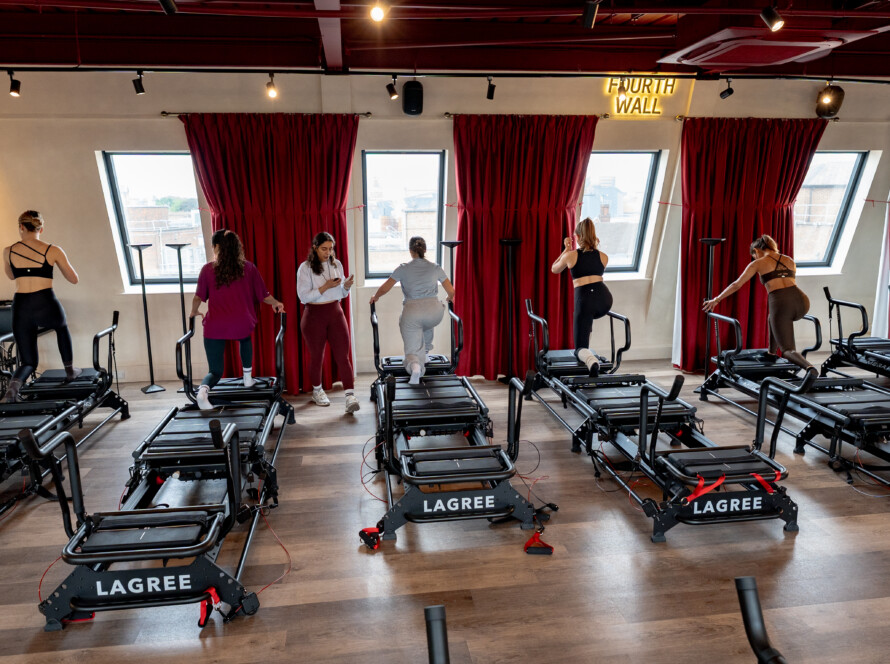You are pregnant and wondering whether to keep your Lagree Workout or switch to something gentler. Can you do Lagree while pregnant and still protect your pelvic floor, core, and balance without adding joint pain or dizziness? This article provides clear guidance on prenatal safety, trimester-specific modifications, low-impact resistance training, and how to obtain proper clearance and cues from your doctor and instructor.
Blood, Sweat, and Tears’ Lagree in London offers guided prenatal options with experienced instructors who adapt Megaformer moves for pregnancy, focusing on breath control, posture, pelvic floor care, and safe modifications so you can stay strong and comfortable.
Understanding Prenatal Exercise Guidelines

ACOG recommends 150 minutes of moderate-intensity aerobic activity per week. Moderate means your heart rate rises, but you can still hold a conversation. Resistance training and controlled strength work fit into that target when you keep effort steady and avoid pushing to exhaustion. Track perceived exertion and use the talk test to stay in a safe zone.
Pregnancy Warning Signs You Shouldn’t Ignore
Watch for red flags during any session:
- Vaginal bleeding
- Dizziness
- Chest pain
- Regular painful contractions
- Reduced fetal movement
If any of those occur, stop and contact your provider right away. Ask your obstetrician whether you need any specific limits because of your medical history or current symptoms.
Modifying Lagree for Pregnancy: Practical Adjustments You Can Use
Lower spring tension and reduce speed. Slow controlled repetitions and lighter resistance shift Lagree into a safer, moderate intensity routine. Emphasize stability work over ballistic moves and pick options that let you maintain balance with one hand on the carriage rail.
Avoid lying flat on your back after the first trimester because that position can press on major blood vessels. Skip deep twisting, full sit-ups, heavy Valsalva maneuvers, and rapid core compressions that strain the abdomen or worsen diastasis. Trade a high range of motion for partial ranges and focus on maintaining neutral spine and steady breathing during each rep.
Safer Exercise Substitutions and Pelvic Floor Considerations
Replace single-leg hops and unstable standing progressions with supported versions. Use a broad base of support and hold the bar for balance when trying standing exercises. Substitute seated rows and chest presses for supine presses, and favor standing hip and glute work that keeps your center of gravity lower and controlled.
Check how your pelvic floor responds; if you feel pressure or urine leakage, back off and consult a pelvic floor physiotherapist.
Adapting Lagree Safely Across All Three Trimesters
Trimester-specific notes:
- In the first trimester, you can often continue familiar exercises, but expect fatigue and nausea
- In the second trimester, avoid supine positions and reduce extension of the spine
- In the third trimester, scale back intensity further and prioritize comfort and joint stability
How you feel during and after each class is your best real-time guide.
Why You Should Get Medical Clearance Before Doing Lagree While Pregnant
Ask your OB-GYN for approval before starting or continuing Lagree. They will screen for contraindications such as uncontrolled high blood pressure, placenta previa with bleeding, preterm labor risk, severe anemia, or other pregnancy complications that make exercise unsafe. If your pregnancy is deemed low risk, they can still recommend specific limits and signs to watch.
Partnering With Your Provider for Personalised Modifications
Your provider can also advise on pelvic floor care and screen for diastasis recti so you know which core cues to use or avoid. Suppose you have pelvic pain, round ligament pain, or a history of back instability.
In that case, they may refer you to a prenatal exercise specialist or physical therapist who can adapt Lagree moves to your anatomy and symptoms. Have you documented your current symptoms and exercise history to bring to that appointment?
Related Reading
Can You Do Lagree While Pregnant?

Yes, for many people, Lagree is safe during pregnancy when you adapt the session and get medical clearance first. Lagree uses slow, controlled, low-impact resistance work which supports core and stabiliser strength without heavy joint stress.
Ask your care provider before you start or continue, and tell your Lagree instructor you are pregnant so they can plan modifications.
Why Lagree Helps Pregnant Bodies
The workout builds muscular endurance, posture support, and balanced strength that can ease common pregnancy complaints such as low back strain and pelvic ache. Slow tempo and continuous tension also train breath control and stamina that transfer to labour. Watch for diastasis recti and pelvic floor issues so you keep the abdominal work safe and progressive.
Trimester Practicals: What to Change and Why
- First trimester: Keep intensity moderate, avoid overheating, and focus on movement quality while symptoms such as nausea or fatigue are present. For example, lower spring tension on the Megaformer and shorter sets when needed.
- Second trimester: Expect a shifting centre of gravity and more balance challenges, so replace single-leg balance moves with supported variations and stop supine positions when your provider advises. Use bars and instructor spotting when you try new exercises.
- Third trimester: Scale back resistance, prioritise mobility and breathing, and avoid any moves that provoke pelvic pressure or breath holding. Choose standing stability drills and seated core options that feel steady.
Which Moves to Skip or Modify
Avoid lying flat on your back for extended sets after the first trimester, deep abdominal twists, heavy V-sit type core moves, and any exercise that causes strain in the pelvic floor.
Replace full planks with elevated or incline planks, swap deep twists for gentle rotation with the torso supported, and reduce spring tension for single-leg work.
How to Work with an Instructor Safely
Pick a certified Lagree teacher who has prenatal experience and offers a one-on-one intro session so they can see how your body moves.
During class, ask about:
- Trimester-appropriate modifications
- Supervised progressions
- How they monitor:
- Breathing
- Core recruitment
- Pelvic floor engagement
Warning Signs to Stop Immediately
- Vaginal bleeding
- Regular uterine contractions
- Chest pain
- Sudden dizziness
- Severe headache
- Sudden swelling
- Shortness of breath
- Noticeable decrease in fetal movement
If symptoms appear, pause exercise, tell your instructor, and contact your care provider without delay.
What the Research Shows
Reviews and clinical guidance support moderate intensity resistance and core conditioning during pregnancy when tailored to the person and cleared by a clinician. One published review on the National Library of Medicine stresses medical clearance, individualised plans, and professional supervision for exercise in pregnancy.
Experience Lagree in a Supportive, Women-Focused Space
BLOOD, SWEAT & TEARS provides a women-focused fitness space that helps clients achieve their fitness goals faster than other workouts, without the risk of injury; our certified instructors complete a rigorous mentorship program so every class is:
- Fun
- Uplifting
- Motivating
- Effective
- Safe
Book a taster to try Lagree in London. In just 45 minutes of combined strength and cardio, most clients feel and see a difference within two weeks, so book a class to see why Lagree has been America’s fastest-growing workout for three years running.
Recommended Modifications for Pregnant Lagree Participants

First Trimester: Keep Your Routine, Aim for Maintenance
Most people cleared by their doctor can continue Lagree in the first trimester. Treat sessions as maintenance rather than attempts at new personal bests. Expect higher fatigue, so plan for extra rest breaks and shorter sets when needed.
Monitor perceived exertion rather than strict heart rate zones, and stop if you feel:
- Dizzy
- Overly breathless
- Overheated
How should you tweak movements early on? Lower intensity can be achieved by reducing resistance and shortening the time under tension. Replace maximal core holds with gentle pelvic floor engagement and small, controlled movements. Keep hydration and a cool environment within reach to prevent overheating.
Second Trimester: Shift Positioning and Protect the Core
Avoid lying flat on your back for prolonged periods to reduce the risk of supine hypotension. Replace back-of-machine supine work with front-of-machine or standing alternatives.
- Cut out heavy abdominal crunching
- Deep twisting
- Any moves that increase intra-abdominal pressure or provoke a coning of the belly suggest diastasis recti.
Which standing cues help stability? Use the pole or hand support during single-leg and balance demands. Slow transitions and a smaller range of motion reduce fall risk as your center of gravity shifts. Reduce spring tension on the Megaformer to allow joints to move through pain-free, controlled ranges, thereby protecting connective tissue that has loosened under the effects of pregnancy hormones.
Third Trimester: Prioritize Comfort, Control, and Balance
Shift to wider stances and lower, safer centers of gravity to improve stability. Slow every transition and favor controlled, low-impact sequences on the Megaformer. Reduce resistance further and shorten class length as needed to keep movements quality-driven instead of load-driven.
Safe Lagree Modifications for Pregnancy: Support, Breath, and Core Focus
What exercises stay useful now? Standing pushes, gentle squats with pole support, side lying leg work on the carriage, and seated or front of machine core stability drills that focus on the pelvic floor and breath.
Avoid positions that compress the belly or require prolonged supine holds. Bring a spotter or instructor when attempting new modifications and stop if you experience:
- Any pain
- Bleeding
- Decreased fetal movement
Safety Considerations

Pregnancy and Lagree Must-Do Checklist
Get medical clearance before you continue Lagree as a pregnant client, and update your clearance if your provider flags:
- A high-risk pregnancy
- Placenta previa
- Other specific restrictions
Monitor exertion with perceived effort rather than chasing heart rate targets, because pregnancy changes cardiovascular response, and heart rate can be misleading.
Stay hydrated, avoid overheating, and stop if you feel:
- Dizziness
- Unusual shortness of breath
- Chest pain
- Vaginal bleeding
- Significant decrease in fetal movement
Use a certified instructor who understands prenatal exercise and can plan trimester modifications and safe workouts during pregnancy.
Balance and Stability: Keep a Hand on It
Pregnancy shifts the center of mass and raises the risk of dizziness from a higher resting heart rate and increased blood volume, so hand support is essential during standing work on the Megaformer.
Always hold the pole or other support when standing; do not stand without hand support. Which moves should you avoid entirely? Avoid high-risk standing moves, such as Super Lunge, 5th Lunge, and Escalator Lunge, as they require unsupported balance and increase fall risk.
Machine Positioning: Front of the Megaformer for Safer Work
Exercises at the back of the machine demand more balance and more core and single-leg control. After entering the second trimester, move equivalent sequences to the front of the Megaformer where your hands are available and your base is wider.
Lower resistance and a shorter range of motion are beneficial, and you can choose variations that keep your center of mass lower while preserving core stability and pelvic floor awareness, so you still get strength benefits from low-impact resistance training.
Supine and Prone Positions: Avoid Lying Flat by the Mid-Second Trimester
By mid-second trimester, avoid lying flat on your back or on your stomach to prevent compression of major vessels and the risk of supine hypotension syndrome.
Right side down positions should also be limited, as positional compression can vary:
- Use elevated supports
- Propped seated positions
- Side-lying when a move requires a supine or prone start
If lying flat triggers nausea, lightheadedness, or a drop in blood pressure, shift to a seated, elevated, or side-supported position.
Postpartum Considerations: When to Return and How to Rebuild
Resume Lagree only after physician clearance, typically six to twelve weeks postpartum, depending on delivery type and individual healing, and start with one-on-one rehabilitation if possible.
Focus on reestablishing:
- Pelvic floor coordination
- Deep core engagement
- Closing the diastasis recti before loading high resistance
Progress resistance training slowly and use trained instructors skilled in postpartum recovery. Watch for signs that you are returning too fast, such as:
- Urinary leaking
- Pelvic heaviness
- Pelvic pain
- Midline bulge
- Adjust the program accordingly
Lagree with Certified Instructors You Can Trust
BLOOD, SWEAT & TEARS offers a women-focused fitness space that helps clients achieve their fitness goals faster than other workouts, without the risk of injury. By combining strength building and cardio in a 45-minute session, you’ll see and feel results quickly.
Try Lagree in London. All instructors are certified, complete a rigorous mentorship program, and deliver fun, uplifting, motivating, and safe classes. Book a class to experience guided, results-oriented training.
Related Reading
Benefits of Lagree for Pregnancy

Can You Do Lagree While Pregnant? Clear Rules and Real Benefits
Many pregnant women can practice Lagree with medical clearance and proper modifications. Ask your obstetrician about any pregnancy complications before you start or continue. Work with a trainer who knows prenatal exercise and the Megaformer so they can adjust spring tension, range of motion, and positions for your trimester.
Watch your breathing, avoid breath holding, and stop if you experience:
- Dizziness
- Bleeding
- Shortness of breath
- Regular contractions
Easing Joint Pain Without High Impact
Pregnancy often brings joint tightness and pain as synovial fluid production drops and joints compress. Lagree uses slow, controlled, low-impact movements on the Megaformer, so you reduce pounding while still loading muscles.
That steady, spring-based resistance strengthens the muscles around the hips, knees, and lower back, which can unload painful joints during daily tasks and reduce discomfort when you:
- Walk
- Climb stairs
- Carry a baby
Build Endurance and Comfort for Everyday Pregnancy
Lagree emphasizes time under tension to tax muscle endurance rather than heavy loading. You stay in controlled positions longer, which trains muscles to resist fatigue. Improved muscular endurance helps you stand, move, and recover during long days of pregnancy.
The method also supports cardiovascular fitness when classes keep a steady pace, and you can scale intensity to a moderate level that feels sustainable.
Prepare Your Body for Labor with Strength and Stamina
Stronger, more enduring muscles reduce the physical strain on your body. Research shows women who exercise three times a week tend to have shorter labors and lower odds of needing an epidural.
One 2018 study found a nearly an hour reduction in active labor for regularly active women. Lagree’s focus on sustained muscular effort and controlled breathing builds the strength and stamina that assist during pushing and prolonged labor phases.
Train Your Core and Pelvic Floor Safely
You can improve core control without aggressive abdominal compression. Lagree trains the deep core and hip stabilizers through controlled spring resistance and alignment work. In pregnancy, avoid maximal rectus abdominis strain and heavy Valsalva.
Favor exercises that encourage pelvic floor coordination and gentle transversus abdominis engagement, and monitor for any signs of diastasis recti progression.
Practical Modifications on the Megaformer for Every Trimester
Reduce spring tension and shorten ranges of motion as your center of gravity shifts. Avoid long supine holds after roughly 12 weeks; choose side-lying or seated alternatives.
Skip:
- Deep twists
- Heavy ballistic moves
- Prolonged inverted positions
Slow the tempo and use props for balance. Communicate with your trainer about any pelvic pressure or urinary leakage and adjust accordingly.
When to Pause Lagree and Seek Medical Advice
Stop the workout and contact a provider if you experience bleeding, leaking fluid, regular contractions, significant shortness of breath, chest pain, or sudden swelling. High-risk pregnancies, placenta previa after midpregnancy, uncontrolled high blood pressure, or other obstetric restrictions usually mean you should avoid Lagree until cleared.
Always get written clearance if your pregnancy has complications.
How Often to Practice and How to Gauge Intensity
Aim for two to three prenatal sessions per week if your provider agrees. Maintain a moderate level of intensity, where you can still speak in short sentences. Sessions of 30 to 45 minutes suit most clients, but shorten or split workouts if you feel overly fatigued.
Complement Lagree with:
- Walking
- Gentle stretching
- Dedicated pelvic floor work
What to Expect From Your Trainer and Class
A qualified instructor will screen for obstetric risks, modify equipment, monitor your form, and coach breathing and pelvic floor cues. Tell your trainer which trimester you are in and any symptoms you feel during class.
That communication helps them tailor:
- Spring settings
- Exercise selection
- Intensity to your current needs
Related Reading
Book a Lagree Class in London Today

BLOOD, SWEAT & TEARS offers women-focused classes built around the Lagree Method. You get a clean, supportive studio instead of a dirty, boring, creepy gym. Classes run forty-five minutes and blend strength and cardio on the Megaformer so you work endurance, core stability, and muscle tone in one session.
Every instructor is certified and completes a strict mentorship program, so safety, correct form, and effective progress are part of every class. Want to know why clients report visible change in two weeks?
Why Lagree Works Faster Than Most Workouts
Lagree uses continuous resistance at slow controlled tempos to stress muscles without impact. That builds muscle endurance, stimulates metabolic response, and improves posture and core control. The method trains strength and cardiovascular capacity simultaneously using low-impact movements, which reduces joint stress while maintaining intensity.
Controlled movement, precise tempo, and progressive resistance produce fast, measurable results without long workouts.
Can You Do Lagree While Pregnant: Direct Guidance
Many women can continue Lagree during pregnancy with approval from their healthcare provider. Prenatal exercise often includes safe pregnancy workouts like modified resistance training and low-impact cardio.
Pregnant clients should get:
- Medical clearance
- Communicate with instructors
- Use perceived exertion to guide intensity
Avoid overheating, stay hydrated, and stop for any concerning symptoms such as:
- Bleeding
- Dizziness
- Chest pain
- Decreased fetal movement
Have you gotten clearance from your provider?
Trimester-Specific Modifications For Pregnancy
- First trimester: Monitor fatigue and nausea, reduce top-end intensity, and focus on breathing and control.
- Second trimester: Avoid prolonged supine positions, shift core work to supported seated or standing variations, and limit load on the abdomen to protect against diastasis recti.
- Third trimester: Prioritize balance with support, shorten sets, favor seated or supported standing moves, and reduce spring tension on the machine when needed. Keep the pelvic floor engaged but avoid forceful bearing down.
Red Flags and When Lagree Is Not Safe
Do not perform Lagree if you have an unmanaged high-risk pregnancy diagnosis, such as:
- Preeclampsia
- Placenta previa after bleeding
- Preterm labor
- Significant cervical insufficiency.
Also, avoid classes with:
- Uncontrolled hypertension
- Severe anemia
- Recent vaginal bleeding
Stop immediately and seek care if you experience:
- Contractions
- Sudden sharp abdominal pain
- A gush of fluid
- Any alarming symptoms
How Our Instructors Support Pregnant Clients
Instructors screen clients, ask about pregnancy status at booking, and adapt choreography on the fly. They lower spring tension, swap supine sequences for supported alternatives, and cue breath and pelvic floor gently.
Our mentorship ensures instructors can recognize diastasis recti signs and adjust core progressions. Private sessions are available for hands-on attention and a tailored plan.
What To Expect When You Book While Pregnant
When you book, please note your pregnancy and trimester so the instructor can prepare any necessary modifications. Expect a forty-five-minute session with lower-impact progressions, focused breathing cues, and a stronger emphasis on posture and pelvic floor health.
You will work strength and cardio in a supportive group setting with certified staff standing by to adjust intensity.
Classes and Safety Logistics For Pregnant Clients
We sanitize equipment, maintain class sizes that allow hands-on correction when needed, and coach clients to use RPE rather than max effort numbers. Bring water, wear supportive footwear or socks as recommended, and communicate any new symptoms immediately to staff.
Would you like help choosing the best class time and instructor for pregnancy-friendly modifications?





